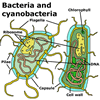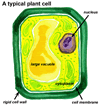Living things show enormous diversity of colour, size, external covering, internal organisation and habitat.
In early classification systems, Man has grouped living things according to the appropriate criteria at that time, e.g. useful, harmful, or neither.
In the 1700s, Swedish taxonomist Carolus Linnaeus classified organisms on the basis of similar structural characteristics. This method is still used today.
The most widely accepted system today, established in 1969 by Whittaker, distinguishes between five major Kingdoms of living things: Animals, Plants, Fungi, Protists and Monera.
(Note: see Animals, Plants and Fungi? - A simplified classification system for more details of these groups.)
- Are heterotrophs, cannot make food by photosynthesis and therefore
need to consume other organisms for food.
- Are usually able to move about.
|
|
- Do not make their own food but absorb nutrients from other organisms.
- Do not move about.
- Mostly consist of many cells.
- Cells are complex (eukaryotic) with nucleus and specialised organelles,
as well as a cellulose cell wall.
- Often can reproduce sexually, and asexually with spores.
Protists
(e.g. single-celled organisms such as Amoeba)
- Are mostly single-celled microscopic organisms, except for the algae,
which are also usually placed in this group.
- The cells are complex (eukaryotic) with nucleus and specialised organelles,
but some also have a cellulose cell wall.
- Some can make their own food: others eat microscopic organisms for
food.
- Reproduce by cell division (asexual reproduction), but sexual reproduction
also occurs through the exchange of some genetic material between the
two organisms.
- Some Protists were formerly classified as single-celled plants if they had cell walls and could photosynthesise, but many could move as well.
|
Current practice is to group these in the Kingdom Protista due to their simple structure and method of reproduction, although not all biologists agree on this. |
|
Monerans
Also referred to as Procaryotes (e.g. bacteria)
- These differ from all other living things in their lack of internal
specialisation at the cellular level.
- These procaryotic cells do not have the chromosomes surrounded by
a nuclear membrane, but the strands of DNA are simply present within
the cytoplasm. There are no other organelles surrounded by membranes,
but all life functions still occur. These cells are less specialised,
therefore less efficient.
|
 |
| Copyright owned by the State of Victoria (Department of Education and Early Childhood Development). Used with Permission. |
|
|||||||||||||||||||||||||||||||||||||||||||||||||||||||||||||||||||||||||||||||||||||

